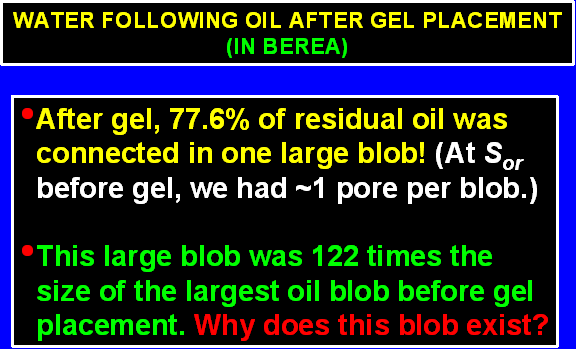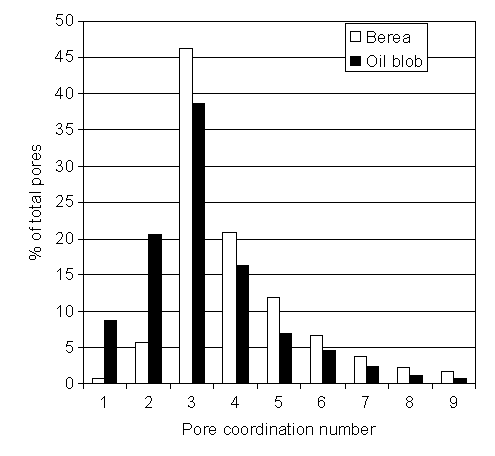Connectivity of Phases after Gel Placement
During study of phase connectivity after gel placement, the most interesting observation was that in Berea the residual oil (resulting from water injection after gel placement) was highly connected. The Sorvalue was 51.0%, and 77.6% of that oil was contained within the largest oil blob. This blob was 122 times larger than the largest oil blob at Sor before gel placement. This high degree of connection helps explain the relatively high permeability to oil after gel placement. The largest blob was widespread, having occupancy in 73% of the pores in the image volume (1,588 out of 2,176 pores).
The pores that were involved with this largest oil blob had nearly the same distribution of pore sizes and water saturations as for all Berea pores in the image volume. For pores that participated with the largest oil blob, the average water saturation was 45%, compared with 49% for all Berea pores in the image volume.
Why should gel allow such a large oil blob to exist? Certainly, the oil phase was expected to be more connected for an Sor value of 51% than for 19.4%. Also, if oil was flowing within the porous media (at any fractional flow), the oil phase should be highly connected. However, at Sor=51% after gel placement, no oil flowed, so this non-flowing oil phase must have existed as discrete blobs. The key question is, why should the blob be so large?

We speculated that the gel located in the extremities of individual pores (i.e., near pore walls, especially in the vicinity of greatest pore radius) might reduce the effective pore radius to more closely match the effective throat radius. Thus, the effective pore body/pore throat aspect ratio could be reduced to allow residual oil to remain connected through multiple pores. (In other words, with a lower aspect ratio, residual oil drops would be less inclined to snap off and become trapped as “singlets” in individual pores, as occurs at Sor before gel placement.) This scenario is consistent with that suggested in Ref. 17. To test this hypothesis, we analyzed the largest oil blob (at Sor after gel placement) as if it were a porous medium (i.e., with the oil representing the pore space, and everything outside the oil blob acting as “rock”). We found the “pore bodies” in the oil blob had a size distribution that closely paralleled the distribution for the original Berea sandstone.
The distributions of aspect ratios are compared in Figure 22. Aspect ratio was defined as the effective pore radius divided by the effective throat radius. The effective pore radius was determined by assuming that the measured pore volume was spherical. The effective throat radius was determined by assuming that the measured throat area was circular. (In reality, although our pore volumes, throat areas, and shapes were known with reasonable accuracy, the pores were decidedly not spherical, and the throats were not circular.)

Contrary to our speculation, the gel did not reduce the effective pore body/pore throat aspect ratio. Instead, the average value (5.5) for the “aspect ratio” for the oil blob was 31% greater than that for Berea sandstone (4.2). For Berea pores, the peak in the distribution occurs at values from 2 to 3. In contrast, for the oil blob, the distribution peaked at values from 5 to 10.
The increase in aspect ratio associated with the presence of the gel might suggest that gel had a greater propensity to reside in pore throats than in pore bodies. However, the increased aspect ratio seems inconsistent with the existence of the large residual oil blob. With greater aspect ratios, why did the large oil blob not break up into many smaller blobs? A possible explanation is that water did not have access (or had limited access) to most of the pore throats after gel placement. With limited or no access, free water could not accumulate in pore throats to cause snap-off and form smaller oil blobs. The affinity of the gel to retain water could also explain why free-water films did not form and break up the largest oil blob.
The distribution of coordination numbers for Berea and the largest residual oil blob are compared in Figure 23. Coordination number is the number of distinct exits from a given pore body. The average coordination number (3.6) for “pores” in the oil blob was 19% less than that for Berea sandstone (4.45). The peaks in the distributions occurred at a value of 3 in both cases. However, the oil blob had a much greater fraction of pores with low coordination numbers.
